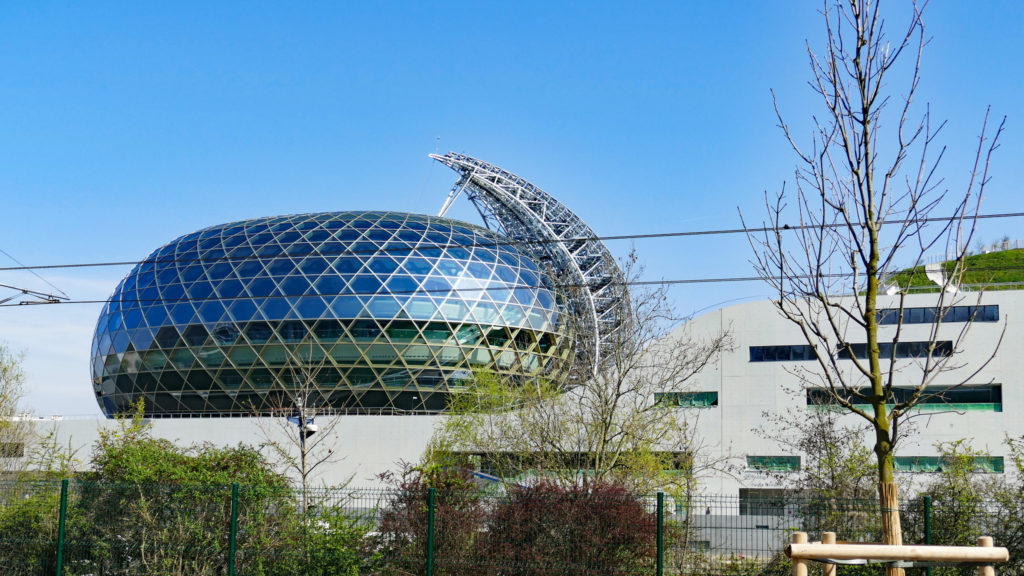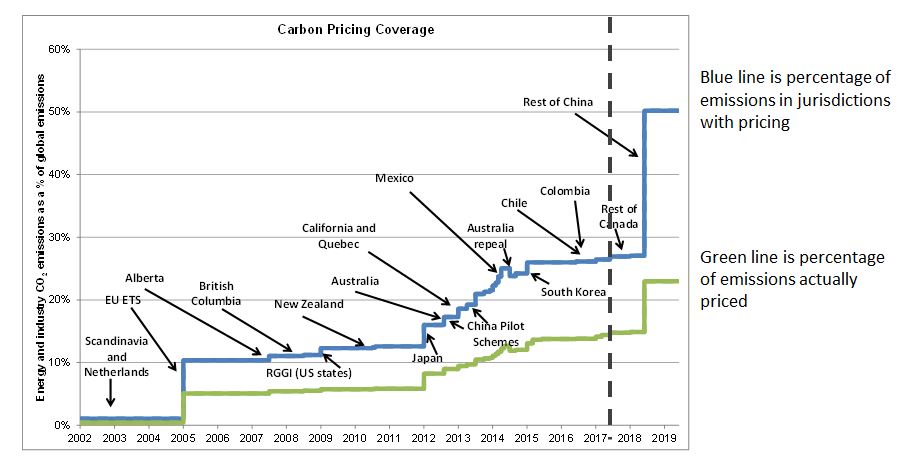 The moment when 196 countries signed on to this Agreement and the ratification threshold was met in 2016, the Requiem for inappropriately low carbon prices started playing in the background. Policies that don’t account for the cumulative effects of burning GHG in the atmosphere can no longer be deemed compatible with the ‘well below 2 degrees’ temperature limitation commitment.
The moment when 196 countries signed on to this Agreement and the ratification threshold was met in 2016, the Requiem for inappropriately low carbon prices started playing in the background. Policies that don’t account for the cumulative effects of burning GHG in the atmosphere can no longer be deemed compatible with the ‘well below 2 degrees’ temperature limitation commitment.
And yet, only 13% of global emissions are covered currently by a carbon price, and the prices are typically much lower than the true social and environmental cost of carbon. This has contributed to the huge gap between the world’s commitments under the Paris Agreement and its track record so far, as highlighted by the UNEP 2017 Gap Report.
So when less than a month after the COP 23 we have 6 Ministers of EU countries talking about introducing a “meaningful” carbon price, we know that they are seeking to solve a problem: how to bridge the gap between the current outdated economic, environmental and industrial models still in place and those needed to reflect the issues of the current post-Paris Agreement century. The heads of state which announced the introduction of regional carbon pricing last week during President Macron’s One Planet Summit made an indirect commentary on the inappropriateness of the current carbon pricing in Europe and their willingness to mind the gap and build a bridge to go beyond it. ‘Meaningful’ can then be read as a strong enough level that will act as a bridge to the Paris Agreement world and shift investment flows towards a net-zero emissions economy.
Good news from the One Planet Summit indeed but hopefully we can start getting used to this type of news and treating it as ‘normal’. As it stands, carbon pricing is only implemented in regions that cover less than 30% of all emissions around the world, and in the jurisdictions where carbon pricing has been introduced, it is usually only applicable to some sectors of the economy. This means that we can and we should expect rapid developments in this regard, in the very near future.
 Source: https://onclimatechangepolicydotorg.wordpress.com/carbon-pricing/the-spread-of-carbon-pricing/
Source: https://onclimatechangepolicydotorg.wordpress.com/carbon-pricing/the-spread-of-carbon-pricing/
As shown in this graph, the EU ETS is only part of the story. The scheme was praised for its innovative stance a decade ago but critiqued for its implementation ever since. Indeed, simply pricing carbon is not enough: the price signal has to be strong enough to steer investments and to reflect the social cost of carbon. And whatever the views on the overall effectiveness of the EU ETS, consensus is emerging that it failed to deliver an appropriate and reliable carbon price for the sectors covered. Appropriate as in delivering a price sufficient to trigger fuel switch, which at the moment the EU ETS isn’t, since the most polluting technologies are staying online while the carbon neutral technologies are replacing less polluting ones. Reliable as in a price close to what the parameters in its design foresaw – at the moment the price is 4 times lower and has been 6 times lower last year.
This means that if carbon pricing in the EU is to deliver a path to meeting our commitments under the Paris Agreement, we need to build bridges to take us closer to where we need to be. Last weeks’ news is about building bridges. 6 EU Governments (Germany, Sweden, the Netherlands, France, UK and Luxembourg) have committed themselves to building bridges to go beyond the EU ETS and introduce ‘Meaningful’ national carbon pricing towards something that will most likely develop into regional carbon pricing.
Sandbag has been continuously and fervently asking policy-makers to ‘mind the gap’ between the EU ETS cap, set too generously, and the actual level of emission in the EU (currently, Dec 2017 at -11% below the cap) – as the primary element determining the price of EUAs. As the ETS reform concluded with a late night trilogue taking place while a COP was unfolding just 200 Km next to the negotiation room in the Council, it was clear to all those who’ve been working on this file for some time now that the reform was not going to deliver the long-awaited bridge to a meaningful carbon price (at least not in the short to medium terms).
What is a meaningful carbon price? One that reflects the social carbon and environmental cost (nothing in single digits like the EU ETS has been giving for most of Phase 3), one that provides investment signals for decarbonisation and that takes the most polluting technologies offline – in other words, the definition of a price driving decarbonisation cost-effectively. According to the High-Level Commission on Carbon Prices, led by Nobel Laureate Joseph Stiglitz and Nicholas Stern, such a price would fall in the range $40-$80 per tonne of CO2 by 2020 and $50-100 per tonne by 2030.
In the EU, the EUA prices have been far from these levels, which means we need to keep building bridges over the gap in appropriate carbon pricing created. A regional carbon price is a first step and it is very welcome, despite the perceived risk that it will create a two-tiered Europe. After all, there is no bigger risk than the one of a unitary Europe which prices carbon inapporpriately.
A Europe with meaningful regional carbon pricing is one with more bridges to the PA than otherwise. The infamous ‘waterbed effect’ will be invoked time and time again in an attempt to counteract ambitious national or regional carbon pricing. Sandbag has proven previously that such a notion is more likely to be a myth than not. However, for the hard believers, we still have the MSR – its introduction in itself was a step towards preventing that. Furthermore, cap adjustments will be needed going further and future reviews have the opportunity to incorporate them into a flexible, dynamic and modern ETS – hence leaving no space for the waterbed myth to be circulated. Until then, however, Member States have the option of introducing meaningful carbon pricing in their own jurisdictions.
We very much welcome the announcement on regional carbon pricing within Sandbag. A week before this announcement was made, Sandbag launched its latest EU ETS report, which essentially is a strategic reform agenda for the next few decades of the EU ETS. The focus of the agenda is clear: we can’t afford to waste any time until the EU ETS price reaches the required levels and until the next revision. During the Brussels launch event, representatives of several EU Governments were present and discussing national and regional carbon pricing additional to the EU ETS. We enjoyed interventions from representatives from the UK, the Netherlands, Belgium, France, Sweden, Estonia and Norway. Our goal was to try to build bridges towards the next revision and towards a better place to adopt ambitious options EU – developing a regional carbon price is a great step in that direction.
The next obvious bridge is for the same countries to also end the support to the most carbon intensive technologies currently online (coal). It is rather counterproductive to on one hand introduce meaningful carbon pricing and on another, keep funding coal as to allow it to withstand the pressure of the carbon price. The Energy Council on the 18th of December revealed that despite the announcement made just a week before, some of the same countries were considering allowing coal plants to stay open through capacity market payments.
For carbon pricing to be able to do its job and build the bridges we need, the obvious second step would be to not undermine it by introducing parallel support mechanisms for polluting technologies such as coal power – a lesson the EU seems to not have learned yet. We are not where we ought to be to even hope to make the 2050 milestones. Any more bridge building appears to then be imperiously necessary.
2018, bring it on for more meaningful bridge building (and carbon pricing)!
Photo of La Seine Musicale (location for the One Planet Summit) with thanks to Daniel ENGELVIN
